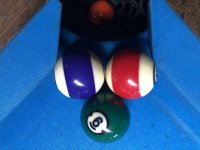How long have tight pockets on American pool tables been a thing? I understand it’s somewhat subjective, but in general.
I’ve heard stories about older players like Wimpy and Cowboy playing on 5x10s with 4 1/2 or 4 1/4” pockets. I even saw an interview with Wimpy many years ago where the interviewer asked Wimpy how he felt about “today’s” (whatever year it was) tougher playing conditions. He said something like, I think you should make the game as difficult as you can.
When I began playing around 20 years ago, 4” or even sub 4” pockets were definitely a thing. My favorite pool room at the time had two “pit” tables, one with 4” pockets and the other with just under 4” pockets. I never thought anything of it, since I watched strong shortstops and pro speed players running out on them. I just thought that’s what good players played on.
So when did the shift happen from 5 or even 5 1/2” corners to where we are today? And what started us down that path?
I’ve heard stories about older players like Wimpy and Cowboy playing on 5x10s with 4 1/2 or 4 1/4” pockets. I even saw an interview with Wimpy many years ago where the interviewer asked Wimpy how he felt about “today’s” (whatever year it was) tougher playing conditions. He said something like, I think you should make the game as difficult as you can.
When I began playing around 20 years ago, 4” or even sub 4” pockets were definitely a thing. My favorite pool room at the time had two “pit” tables, one with 4” pockets and the other with just under 4” pockets. I never thought anything of it, since I watched strong shortstops and pro speed players running out on them. I just thought that’s what good players played on.
So when did the shift happen from 5 or even 5 1/2” corners to where we are today? And what started us down that path?

